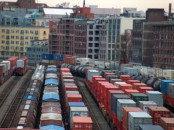Deforestation vs population growth
Is sustainable growth a luxury developing nations can afford?

From the devastating floods that claimed a third of the country last monsoon to the scorching heat that accompanied this year’s summer, climate change is no longer a faint chant by a group of enthusiasts we come across on the news, but a very real, much-needed wake-up call for Pakistan.
Countries worldwide are advised to align their policies with environmentally suitable guidelines. One such suggestion calls for preserving forest cover. The Intergovernmental Panel on Climate Change (IPCC)’s sixth amendment report stresses the adverse implications of deforestation due to the release of carbon dioxide into the atmosphere.
Pakistan’s current forest cover is about 4.8% of the total land area, significantly less than the international recommendation of 12%. On the other hand, according to the latest population census, Pakistan’s population stands at 241.49 million as of 2023, an alarming statistic compared to the country’s thinning resources.
While shouldering the reality of scarce resources coupled with accelerated population growth, countries like Pakistan struggle to make ends meet. Utilising land as a factor of production without compromising the environment is perhaps an unattainable luxury for such countries.
While encountering such a predicament, it is not farfetched to question whether deforestation is the only way to accommodate the needs of a rapidly expanding population. Although countries across the globe, especially ones that are highly advanced in manufacturing and consumption, contribute to the changing climatic conditions, it is the developing world that must bear the brunt of it.
The growing population brings along with it the heightened aggregate demand for goods and services. As consumption picks up pace, so must production. Forest areas must then be carved into manufacturing and agricultural sites. Not to mention, Pakistan boasts one of the highest urbanisation rates in South Asia.
Along with people’s dreams of better opportunities, urbanisation brings to the cities the pressing concern of living space. In such cases, the creation of slums becomes unavoidable.
These flimsy constructions put residents at risk of numerous natural and health-related threats. To address this, policymakers face the dilemma of deforestation versus population, and thus eventually seek to trade forest cover with residential quarters.
When head to head with complications such as unemployment, a cost of living crisis, and countless other economic and social challenges, it becomes impossible for a developing country to set aside resources for environmental protection or recovery.
Therefore, many people argue environmental action is a luxury that only the developed world can afford. Asking a country like Pakistan to enforce environmentally sustainable policies is equivalent to asking it to choose between its people and its land.
While there is no doubt that such a decision truly does require a trade-off, and while a country like Pakistan does not have the resources or the technology to eliminate the said trade-off, it can certainly try to minimise its effect.
Shrugging off the possibility of implementing a policy that is both environmentally friendly and socially or economically commendable is a pessimist take on the matter. One cannot deny that developed nations have far advanced methods and far greater resources to implement in environmentally significant ways. However for a country like Pakistan, that has yet to reach its full potential and capacity, this is an opportunity to build a structure that caters to the environment from the ground up.
Where prospering nations must alter their already running mechanisms to allow for more environmentally sound solutions, we have the chance to incorporate said solutions at the beginning stages of our development.
Such a prospect is unattainable without efforts put into research and innovation. For instance, verticle housing is a great way to create more living space using less land. Likewise, there is a need to alter the utilisation of existing agricultural lands.
The Union of Concerned Scientists, a non-profit science advocacy association set up in the United States, emphasises this particular concept.
Newer methods that are economically superior as well as environmentally safer have to be introduced, which focus primarily on greater crop production using the same amount of land.
To efficiently utilise natural resources, “agro ecology”, an entire field of investigation solely for this respective purpose, is gradually gaining practicality. Such a model worked wonders in both Brazil and the Netherlands which have now improved their agricultural structure greatly and provide to the rest of the world as well.
Environmentalists believe environmental progression to be one of the vital components that would provide our future generations with sustainability. Time has come for authorities to devise operations and procedures ensuring sustainable forestry.
Looking at the population theory of Malthus, there is a need for preventive checks on population growth of Pakistan. Sociocultural ideologies have to be changed and the constitution should come up with policies catering to family planning services in rural and urban regions alike.
Suggesting the promotion of awareness campaigns on paper is one thing and implementing it while keeping in mind our sociocultural fabric is another. By way of illustration, rural families living in poverty mostly rely on agriculture for subsistence. The labour-intensive nature of agriculture, especially given the technology available to small farmers, forces people to opt for larger families to have more helping hands.
The most efficient way to combat this quandary is not to simply educate people about the dire effects of unregulated population growth, but to offer them a sustainable alternative to the root of their problem.
In this case, it could be provision of cheap technology that increases yield and thus income, as referred to above, with little cost to the farmer. Of course, this requires much thought and planning for effective execution, but the purpose of this example is to shed light on how it has become crucial to put careful thought into the solutions we put out.
Meticulously crafted policies can help ease the burden on environment while appeasing the needs of people. There cannot be more land. That is the reality of our planet. We will have in the future, what we preserve today.
So for the sake of tomorrow, we must put our minds to work and hope to implement a balance between our land and our people.
The writer is a student of BS Economics and a content writer
Published in The Express Tribune, August 21st, 2023.
Like Business on Facebook, follow @TribuneBiz on Twitter to stay informed and join in the conversation.



















COMMENTS
Comments are moderated and generally will be posted if they are on-topic and not abusive.
For more information, please see our Comments FAQ